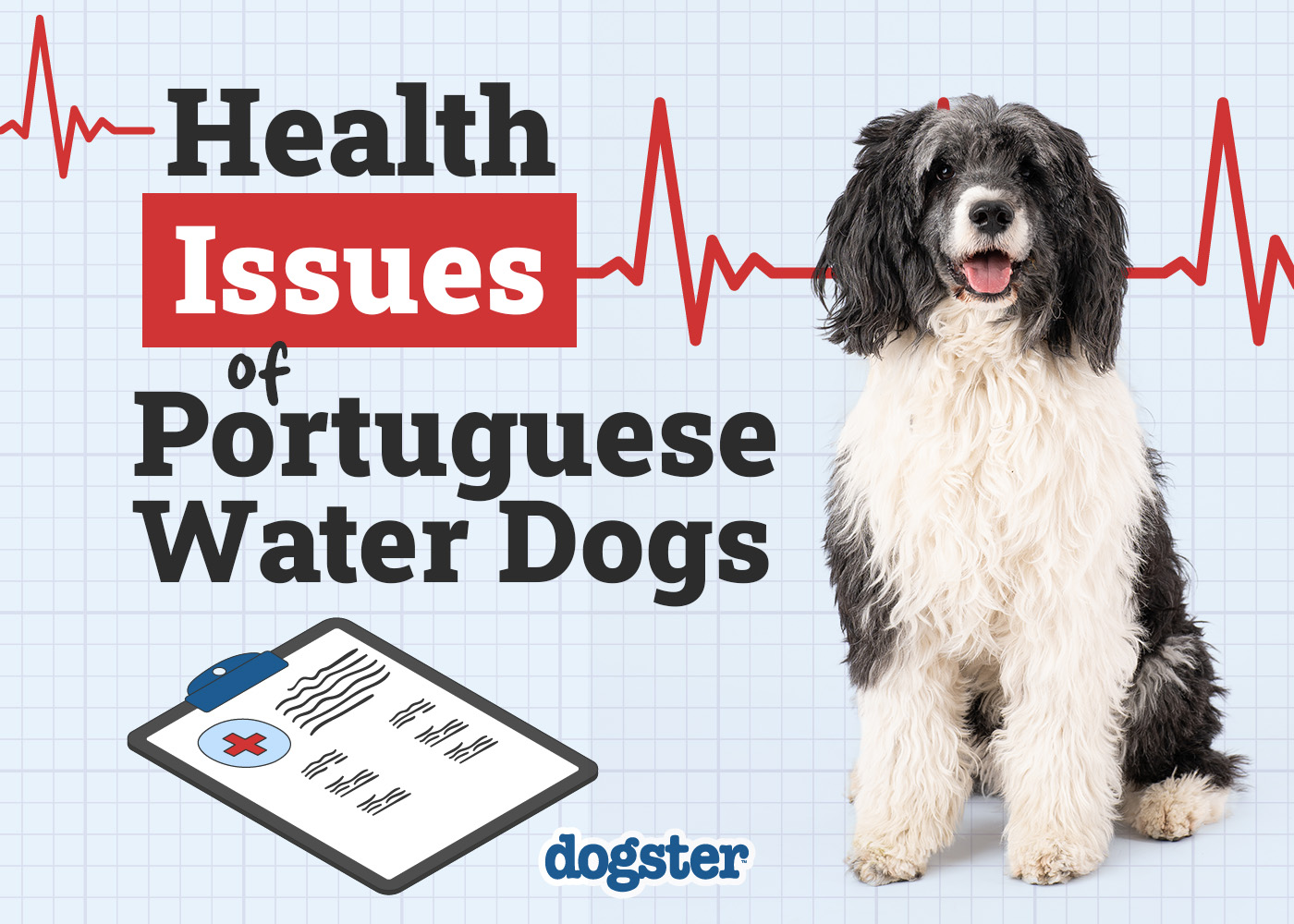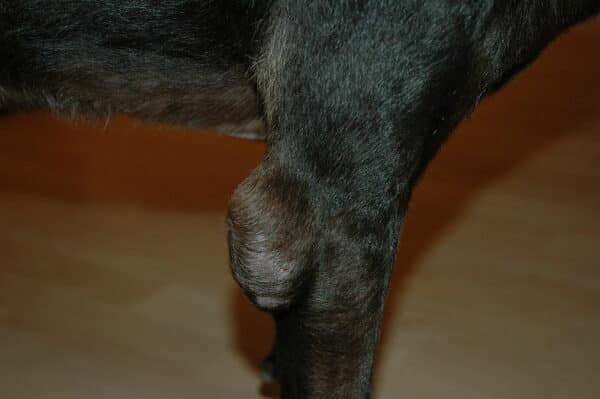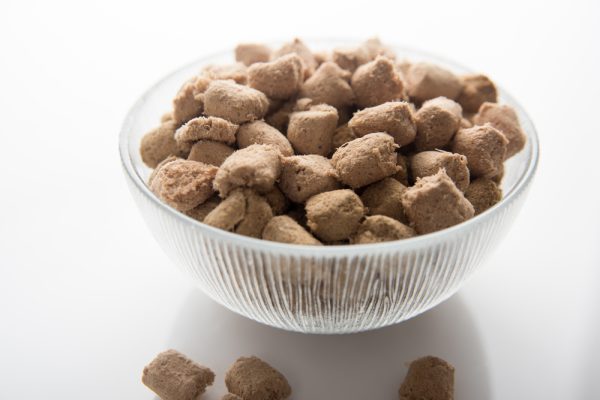In this article
Portuguese Water Dogs make perfect pets due to their affectionate and lovable natures. They are intelligent, friendly, and great around people, making them suitable for all kinds of owners, including singles and families with kids.
These canines are active and agile and require plenty of physical exercise and mental stimulation. They are a generally healthy breed, with their lifespan being between 11 and 13 years. That said, as with all breeds, Portuguese Water Dogs are prone to certain health issues that you should be aware of to help ensure that your furry friend will live a long and happy life.
In this article, we’ll talk more about the possible health issues that Portuguese Water Dogs may experience, along with their causes and treatment options.
Let’s jump right in!

The 8 Common Portuguese Water Dog Health Issues
1. Addison’s Disease (Hypoadrenocorticism)
Portuguese Water Dogs are predisposed to a condition called Addison’s disease (hypoadrenocorticism). It is caused by a deficiency of certain essential hormones that are made by the adrenal glands, primarily cortisol and aldosterone. These hormones have essential roles in the body, including electrolyte balance, hydration, blood pressure, metabolism, and stress responses.
The signs of Addison’s disease are often vague and may wax and wane. It can also resemble various other diseases.
- Lethargy
- Decreased appetite
- Diarrhea
- Vomiting
- Weight loss
- Trembling
- Weakness
These signs can vary from dog to dog, and most of the time, they’re not enough to diagnose the disease. Instead, if they suspect that a dog has Addison’s disease, a vet will take blood work and run urine tests to find any signs consistent with Addison’s, such as imbalances in electrolytes in the dog’s blood sample.
Causes:
There are several possible causes for Addison’s disease in dogs, with the two most common ones being:
- Immune-mediated destruction of your dog’s adrenal tissue
- Tumor/defect of the pituitary gland
It’s also possible for dogs to develop Addison’s disease after treatment for Cushing’s disease or suddenly stopping long-term steroid medication. Although this condition can occur in almost any dog, certain breeds are at increased risk, including Portuguese Water Dogs, Standard Poodles, Great Danes, and Labrador Retrievers.
Treatment Methods:
Most dogs can be successfully treated for Addison’s disease as long as they get a proper diagnosis from a vet. Affected dogs usually require lifelong supplementation to replace the missing cortisol and aldosterone. They may also be treated with an injectable medication known as DOCP (or desoxycorticosterone pivalate), which replaces aldosterone. An oral glucocorticoid, such as prednisone, may also be needed. Some dogs do best on oral medications that replace both hormones, such as fludrocortisone (Florinef).

2. Hypothyroidism
Hypothyroidism is caused by underactive thyroid glands and a resulting lack of thyroid hormones, which play an important part in your dog’s metabolism. If they are decreased, metabolism slows down.
The signs of hypothyroidism usually develop gradually and are often vague.
- Lethargy
- Laziness
- Weight gain
- Chronic skin or ear infections
- Increased skin pigmentation
- Dry, brittle hair
- Thinning hair coat
- Inability to regrow hair
- Dry eye
Causes:
In 95% of canines, hypothyroidism has one of two causes:
- Lymphocytic thyroiditis
- Idiopathic thyroid gland atrophy
In the other 5% of dogs, hypothyroidism can occur due to other health problems, such as thyroid gland cancer. Genetics can also play a role in the odds of this condition developing.
Treatment Methods:
Hyperthyroidism in dogs requires long-term treatment. Your veterinarian will likely prescribe an oral thyroid replacement hormone that your dog will need to take for life. With treatment, the prognosis is excellent, but dogs that don’t receive treatment will have shorter lifespans and may develop other health issues as a result.
3. Cataracts
Portuguese Water Dogs are prone to several eye defects, including cataracts, which is an increase in the opacity of the lenses. Healthy lenses enable light to enter the eyes and focus it onto the retinas. Cataracts cause the lenses to become cloudy and interfere with the passage of light.
Cataracts can vary from dog to dog, so the vision of some canines could be drastically impaired, while others may only have small vision interferences.
- Cloudy eyes
- Impaired vision
- Bumping into things
- Trouble finding food and water bowls
- Hesitant to walk down stairs
- Pain
Cataracts themselves aren’t usually painful, but some of the underlying conditions are.
Causes:
Most cataracts are due to a genetic or hereditary defect. This condition can also occur in dogs with diabetes mellitus.
It can have other causes, including:
- Injury
- Old age
- Uveitis (inflammation inside the eye)
- Glaucoma (high pressure inside the eye)
Treatment Methods:
Unfortunately, no medical therapies can currently cure cataracts, but the problem can be resolved with surgery to remove them. This surgery is typically performed by specialist vets at referral centers. To help keep the eyes healthy afterward, most dogs will need daily eye drops for life.
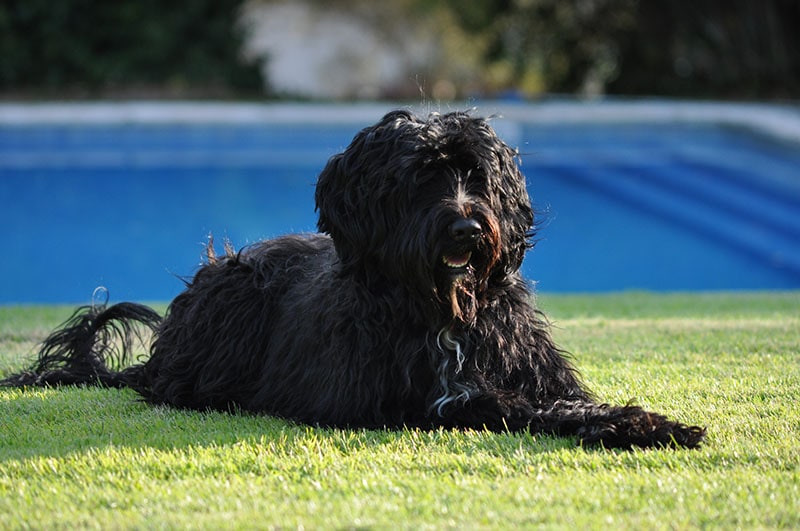
4. Progressive Retinal Atrophy (PRA)
Portuguese Water Dogs are prone to PRA, a term used to describe several inherited, degenerative disorders that lead to vision impairment and blindness in dogs. The time period for the development of this condition may vary, though most affected canines will lose their sight 1–2 years after the first signs occur.
PRA occurs either due to a lack of development in the rods and cones in the retina or due to their atrophy after the dog reaches a certain age. The retina is a thin layer of photoreceptors located at the back of the eye.
The condition can be classified by the age of onset:
- Early-Onset PRA — This type of PRA is also known as retinal dysplasia and occurs in puppies around 8–12 weeks of age. The rods and cones do not develop properly, so affected puppies quickly lose their vision.
- Late-Onset PRA — This type of PRA occurs in adult dogs that are between 3 and 9 years old. The rods and cones atrophy and stop functioning.
- Dilated pupils
- Clumsiness and bumping into things
- Loss of night vision
- Reluctance to go out at night or enter dark rooms
- Eyes that are reflective in the dark
- Cataracts may develop
Causes:
PRA in dogs is an inherited condition that affects several breeds, including the Portuguese Water Dog.
Treatment Methods:
Sadly, there’s no way to cure PRA in dogs, so any affected canine will eventually lose the ability to see; therefore, dogs that carry PRA genes typically shouldn’t be bred.
If your Portuguese Water Dog suffers from PRA, you should do everything in your power to make life easier and less stressful for your furry companion. Here’s a list of tips that will enable your dog with PRA to live a better and more comfortable life:
- Provide a safe and familiar area where objects and furniture won’t be moved.
- Block off hazardous spots in your home, such as stairs, to prevent accidents.
- Train your dog to rely on verbal cues and gentle touches.
- Ensure that your dog feels loved and secure.
- Modify your dog’s favorite activities in a way that they can still enjoy doing them.
- Use a harness and leash to help your dog navigate.
- Inform people that your dog is blind, and explain how they can approach your furry companion.
If you are concerned about the health and well-being of your pet, we recommend getting in touch with a vet for guidance.
If you need to speak with a vet but can't get to one, head over to PangoVet. It's our online service where you can talk to a vet online and get the advice you need for your pet — all at an affordable price!
5. Juvenile Dilated Cardiomyopathy
Dilated cardiomyopathy (DCM) is a condition that affects the heart muscle, causing it to become thin and weak. The heart becomes enlarged and struggles to pump blood around the body.
Juvenile dilated cardiomyopathy, or JDCM, has been recognized in young Portuguese Water Dogs, with the onset between 2 weeks and 6 months of age.
Unfortunately, it most commonly causes sudden unexpected death, but the signs of heart failure may also be seen, which progress rapidly.
- Rapid breathing
- Weakness
- Inappetance
- Depression
- Blue hue to tongue or gums
- Fainting/collapse
- Sudden death
Causes:
JDCM is a hereditary heart disease caused by recessive genes, so for a puppy to be affected, they need to inherit one recessive gene from each parent.
Treatment Methods:
Unfortunately, there is no treatment for this fatal condition. Linked marker DNA tests are available to ascertain the genetic status of dogs before breeding.

6. Lysosomal Storage Diseases (Gangliosidosis)
Lysosomal storage diseases describe a group of disorders that affect the production of necessary metabolic enzymes that your dog needs for normal body function. Portuguese Water Dogs can be affected by one called gangliosidosis. This causes a lack of enzymes in charge of breaking down molecules on the brain’s surface and the surfaces of your dog’s neural cells.
- Twitching of the eyes
- Decreased vision
- Weakness
- Lethargy
- Dementia
- Tremors
- Seizures
- Lack of coordination
Causes:
Gangliosidosis is an inherited, recessive genetic disorder. The missing enzymes cause the clinical signs.
Treatment Methods:
Unfortunately, there are no proven treatments for gangliosidosis and other lysosomal storage diseases. These conditions are usually fatal for canines. Fortunately, they are quite rare, and responsible breeders will screen their breeding dogs through genetic testing. Some dogs are carriers and should not be bred.
7. Hip Dysplasia
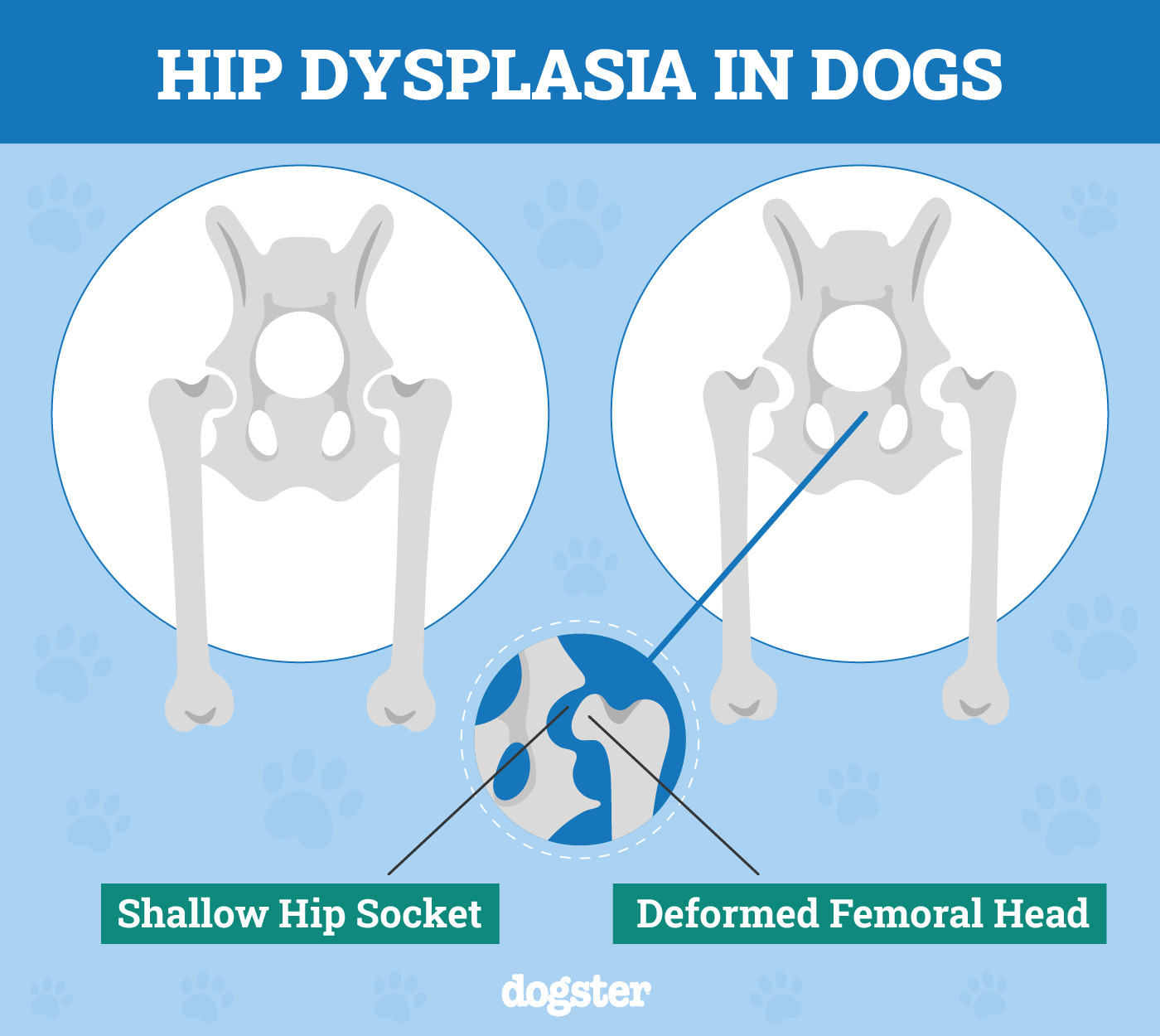
Hip dysplasia is a common health problem for many breeds, including Portuguese Water Dogs. This condition occurs in a dog’s growth stage due to the hips not developing properly, leading to loose hip joints and frequently, osteoarthritis.
The signs of hip dysplasia vary depending on the individual and how severe the disease is. Some dogs with a mild form may not show any signs until they are older and develop arthritic hips. The signs may include:
- Stiffness after rest
- Limping/lameness
- “Bunny hopping,” running with both back legs together
- Wobbly/swaying back-end when walking
- Reluctance to exercise
- Pain
Causes:
Hip dysplasia is primarily a genetic health problem that can be affected by various other factors, including diet, exercise, growth rate, hormones, and muscle mass. The condition most commonly occurs in medium and large dogs, though it can happen in any breed. The only way to prevent it is to stop breeding dogs with the condition. Screening programs are available to check that potential breeder dogs have healthy hips.
Treatment Methods:
The best way to ensure that your dog won’t suffer from the long-term effects of hip dysplasia is to diagnose the condition early and get the needed treatment options from your vet.
There are several ways of managing and treating hip dysplasia in dogs. Your veterinarian will decide on the right treatment plan for your Portuguese Water Dog based on their current pain and discomfort levels and clinical signs. These include:
- Weight control
- Non-steroid anti-inflammatory drugs
- Joint supplements
- Controlled exercise
- Physical therapy
- Surgery

8. Inflammatory Bowel Disease (IBD)
Portuguese Water Dogs may also be more susceptible to IBD. This condition occurs as a reaction to chronic irritation of the GI tract, leading to inflammation. Most dogs suffering from IBD have a history of diarrhea and vomiting and may generally have a poor appetite.
- Weight loss
- Lethargy
- Loose stools
- Increased urgency to defecate
- Vomiting
- Diarrhea
Causes:
IBD is caused by an abnormal immune response causing inflammation in the gastrointestinal tract.
The exact underlying cause often cannot be identified, but possible causes include:
- Bacterial infections
- Adverse food reactions (usually to a protein)
- Parasites
Since certain breeds are more susceptible, genetics are also likely to play a role.
Treatment Methods:
Treatment varies depending on the severity of the disease. Here is a list of treatments that can be used to help dogs suffering from IBD.
- Exclusion diet (under vet advice)
- Probiotics
- Worming
- Prescription medications to reduce inflammation

Summary
Although the Portuguese Water Dog is a generally healthy breed, there are still several health conditions that they can be susceptible to. The most important part of being a responsible dog parent is ensuring that your furry friend gets regular vet check-ups, as these will help you discover health issues in time and react properly in order to help your dog.
Featured Image Credit: Brook Robinson, Shutterstock
